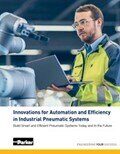By MCE and Parker Hannifin Teams
For today’s industrial pneumatic systems, automation and efficiency continue to be the driving factors in design. Automation in pneumatics incorporates a variety of design strategies and considerations. When it comes to industrial machinery, Industry 4.0 and the Industrial Internet of Things (IIoT) are big buzzwords, but these solutions are not fully developed yet. For design engineers working toward creating closed-loop automated systems, questions for consideration include:
- How do you develop the next-generation Smart Factory?
- What is the path toward a fully automated factory?
- How can maintenance requirements be triggered without any downtime?
- What data input can you use and how do you capture that data?
- How do you diagnose maintenance issues at the component, system, or process level?
Smart connected pneumatics
For design engineers, smart pneumatics can mean complete flexibility; this is the ability of that component to communicate over the network, multiple uses for a single device, ease of integration and commissioning, as well as troubleshooting. Smart products are where you see the most difference in pneumatic systems. The diagnostic aspect of smart pneumatics is important to help achieve zero downtime.
Cobots and safety
In automotive manufacturing, robotics have been in use for more than a decade, and over the years, they have shifted from being hydraulically driven to being pneumatically driven.
What is a cobot? Cobots in manufacturing are collaborative robots that work with humans on the factory floor.
In industrial cobot applications, collaborative robots, known as “cobots” work with humans in some way, including as an assistant or guide in a task or process. Unlike autonomous robots, cobots, do not work alone. They are designed to work with human instruction or respond to human behavior. The shift to pneumatics for robotics means that cobots are primarily pneumatically driven.
A team works on operating a cobot
Cobots are the next big thing in industrial applications as the cost of robotics comes down and newer opportunities are being developed. Leading cobot applications include:
- Machine tending where cobots can load and unload tools and accessories to decrease manual handling.
- Pick and place where cobots can complete careful packing and moving, then place and position products or parts.
- Assembly and flexible manufacturing where cobots insert parts, screwdriver, and other assembly tasks with appropriate end-of-arm tools.
- Packaging, loading, and unloading when aided by suction or gripper attachments, cobots move finished products through packaging.
Safety in collaboration of manual and automated
The strict separation between the manual work of the factory worker and the automated actions of robots is becoming an increasingly gray area. Their work ranges are overlapping and merging into a collaborative working space. In doing so, humans and machines will be able to simultaneously work together on the same workpiece or component in the future—without having to be shielded from each other for safety reasons.
Due to this, safety is the largest consideration in the design of cobot applications. However, there can be some confusion on which safety standards to follow in applications with cobots due to the divide between traditional pneumatics and entering the world of robotics. As standards and their adoption vary among engineers and facilities, it is important to know which standards to apply.
For incorporating cobots into a plant, engineers must understand the required standards for the facility and compile the necessary documentation and technical file with due diligence, testing, and validation of the controls architecture.
Smart pneumatic system efficiency
Lower upfront and maintenance costs combine to make pneumatics the most popular and cost-effective choice for executing mechanical motion. New improvements in designs and efficiency of compressors, and the standard use and distribution of clean dry air in a manufacturing facility, also make pneumatics a good choice for industrial automated machinery.
Smart pneumatics aim to help generate and maximize data and minimize compressed air use.
Compressed air use by industrial machines is a close second to the use of electricity in terms of cost, and well ahead of other utilities such as water and natural gas in most plants and facilities. Electricity is less expensive per dollar of unit energy, but compressed air and pneumatics have many other advantages encouraging their use.
Effective pneumatic systems need properly sized, installed, and maintained components from compressors to workstations. A few wrong choices can lead to everything from wasted energy to system failures. Conversely, even seemingly small design tweaks can add up to large improvements in pneumatic system efficiency. These changes can save air, reduce costs, improve overall utilization, and reduce downtime in operation.

Download our white paper Innovations for Automation and Efficiency in Industrial Pneumatic Systems and gain insight into designing integrated smart pneumatic systems that deliver in-plant efficiency.
Parker's Purpose is all about how we impact the world around us. It's about using our expertise to enable engineering breakthroughs in collaboration with our partners and supporting our customers. It's about nurturing customer ideas—from complex challenges to real life applications.
Interested in learning more about our smart pneumatics and automation offerings? Contact us to learn more or request a quote today!